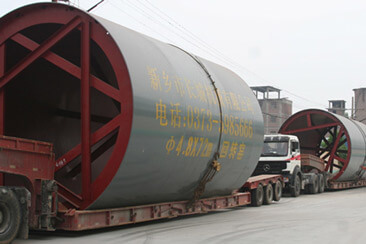
News Date:2016-08-26 14:39:03
Clinker production is the most energy intensive stage in cement production line, accounting for over 90% of total industry energy use, and virtually all of the fuel use. Clinker is produced by pyroprocessing in a large rotary kilns. These rotary kiln systems evaporate the inherent water in the raw meal, calcine the carbonate onstituents , and form cement minerals . any different fuels can be used in the rotary kiln. In these rotary kilns a tube with a diameter up to 8 meters (25 feet) is installed at a 3-4 degree angle that rotates 1-3 times per minute. The ground raw material, fed into the top of the kiln, moves down the tube counter current to the flow of gases and toward the flame-end of the rotary kiln, where the raw meal is dried, calcined, and enters into the sintering zone. In the clinkering zone, the combustion gas reaches a temperature of 1800-2000°C (3300–3600 °F). While In a wet rotary kiln, the raw meal typically contains approximately 36% moisture. These kilns were developed as an upgrade of the original long dry kiln to improve the chemical uniformity in the raw meal. The water is first evaporated in the rotary kiln in the low temperature zone. The evaporation step makes a long kiln necessary. The length to diameter ratio may be up to 38, with lengths up to 230 meters (252 yards). The capacity of large units may be up to 3600 tonnes (3970 short tons) of clinker per day. Fuel use in a wet kiln can vary between 5.3 an G In a dry rotary kiln, feed material with much lower moisture content (0.5%) is used, thereby reducing the need for evaporation and reducing kiln length. The first development of the dry process took place in the U.S. and was a long dry kiln without preheating . Later developments have added multi-stage suspension preheaters or shaft preheater. Pre-calciner technology was more recently developed in which a second combustion chamber has been added between the kiln and a conventional pre-heater that allows for further reduction of kiln fuel requirements. The typical fuel consumption of a dry kiln with 4 or 5-stage preheating can vary between 3.2 and 3.5 GJ/tonne clinker, electricity use increases slightly due to the increased pressure drop across the system. A six stage preheater kiln can theoretically use as low as 2.9-3.0 GJ/tonne clinker. The most efficient preheater, pre-calciner kilns use approximately 2.9 GJ/tonne clinker

Once the clinker is formed in the rotary kiln, it is cooled rapidly to minimize the formation of a glass phase and ensure the maximum yield of alite formation, an important component for the hardening properties of cement. The main cooling technologies are either the grate cooler or the tube or planetary cooler. In the grate cooler, the clinker is transported over a reciprocating grate through which air flows perpendicular to the flow of clinker. In the planetary cooler (a series of tubes surrounding the discharge end of the rotary kiln),the clinker is cooled in a counter-current air stream. The cooling air is used as secondary combustion air for the rotary kiln.